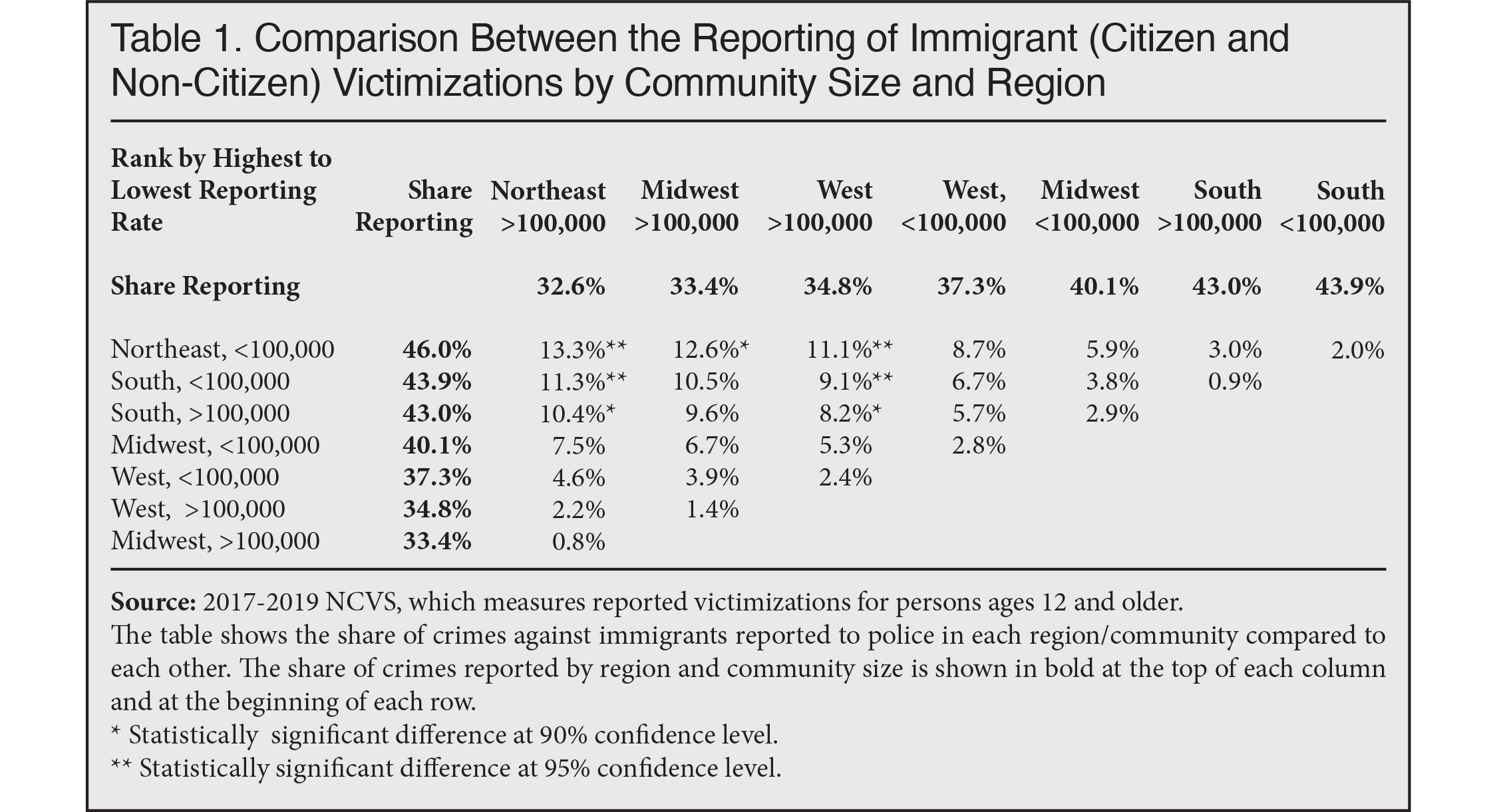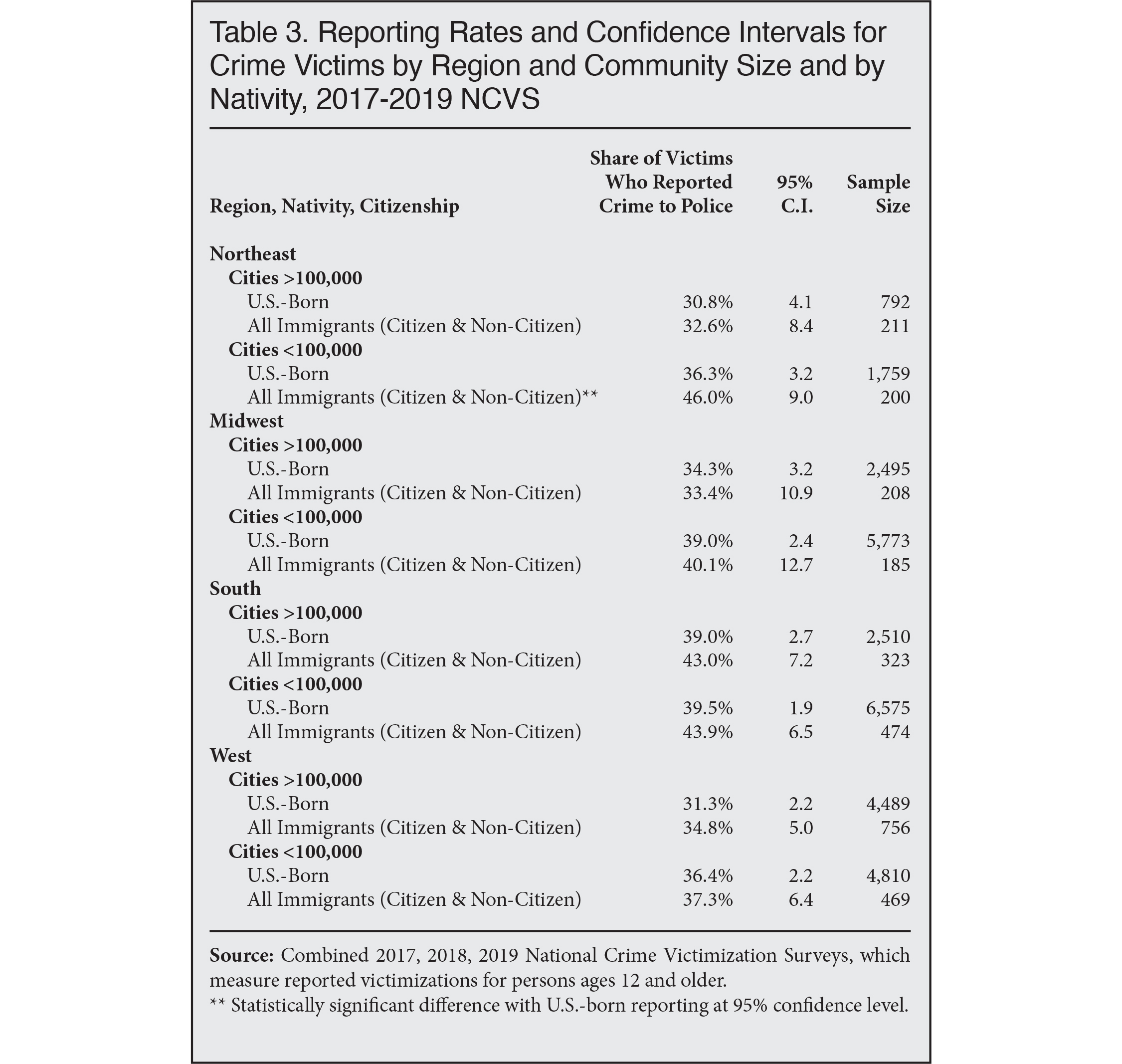The contention that immigrants are reluctant to report crimes is one of the most frequently cited justifications for sanctuary policies. In a new analysis published last week using the National Crime Victimization Survey (NCVS) we found that crimes against immigrants are as likely, or in some cases more likely, to be reported to the police than those against the native-born. Most jurisdictions cooperate with ICE, so it is fair to conclude that this cooperation does not lower the overall share of immigrant victimizations reported to the police.
We also found that crimes against immigrants are reported to the police at similar rates in the South and in smaller communities, where cooperation with ICE is more common relative to the West and Northeast and to larger communities, where sanctuary policies are more common. This blog post attempts to take the analysis one step further by combining regions and community size. We find no evidence that crimes against immigrants are reported at lower rates in smaller communities in the South, where cooperation with ICE is the most common, relative to large communities of the West and Northeast, which cooperate the least.
Ideally, looking at crime reporting rates by immigrant victims across communities with different policies toward ICE could directly measure how such policies impact the share of immigrants who come forward. But unfortunately individual communities or even states are not identified in the public-use NCVS. Even if they were, the sample size of the survey would preclude reliable estimates of crime reporting by immigrants at the local level. However, it is possible to compare crime reporting rates by regions and community sizes together to look for a relationship between cooperation with ICE and immigrants’ willingness to report crimes.
While most jurisdictions do cooperate with ICE, there are dozens of jurisdictions around the country that have adopted laws, ordinances, or other types of sanctuary policies that limit such cooperation in a variety of ways. In contrast, other jurisdictions participate in the 287(g) program, allowing them to make some determinations about immigration status. As we pointed out in our prior analysis by region, cooperation with ICE is more pronounced in the South, while sanctuary jurisdictions are most common in the West and Northeast. Further, as we also discuss in that report, larger communities, particularly America’s largest cities, tend to have sanctuary policies, while smaller communities tend to cooperate the most with ICE.
Table 1 combines region and community size to look for a relationship between immigrant victims’ willingness to report crimes to police. The table is a matrix comparing the reporting of crimes against immigrants in each of the four regions of the country that are identified in the public-use NCVS, further divided into communities of more than 100,000 and fewer than 100,000. Because dividing the data in this way significantly reduces the immigrant sample sizes for specific categories of crime and for subgroups of immigrants, Table 1 is limited to all immigrant victimizations and all crimes. Immigrants are the foreign-born, which includes all persons who were not U.S. citizens at birth: naturalized citizens, lawful permanent residents, long-term temporary visitors such as guestworkers and students, and illegal immigrants.
 |
If the “chilling effect” theory were correct, then we would expect to find the lowest immigrant crime reporting rates in the smaller communities in the South because this is the part of the country and type of community where cooperation with ICE tends to be more pronounced. In contrast, we would expect to find the highest rates of crime reporting by immigrants in the larger communities in the Northeast and West, where sanctuary policies are the most numerous. The results in Table 1 do not support the idea that relatively higher levels of cooperation with immigration authorities in smaller southern communities reduces immigrant reporting of crimes.
It is true that small communities in the Northeast have the highest crime reporting rates. But it also shows that smaller communities in the South, followed by larger cities in the South, have the next-highest reporting rates for immigrant victimizations. And there is no statistically significant difference between the South (large or small communities) and small Northeastern communities. The table also shows that larger communities in the West and Northeast have among the lowest rates of crime reporting. This certainly does not support the idea that sanctuary policies increase crime reporting by immigrant victims, as these regions and types of community typically do not cooperate with ICE.
Table 2 summarizes the statistically significant results in Table 1. Table 2 shows, as already noted, that smaller communities in the Northeast have higher reporting rates than larger communities in the Northeast, and larger communities in the Midwest and West. Table 2 also shows that both smaller and larger communities in the South have higher reporting rates than larger communities in the Northeast and in the West. The relatively high level of cooperation with ICE in the smaller communities in the South and the relatively low level of cooperation in large communities in the Northeast and West does not have the effect that proponents of the chilling effect theory would predict. (Table 3 shows more detailed information, including sample size.)
 |
While in general the results in Tables 1 and 2 indicate that cooperation with ICE does not reduce immigrant crime reporting and sanctuary polices do not seem to increase it, there are significant limitations to the analysis. The biggest limitation is that the country is only divided into eight geographic units. There is significant variation within regions and communities of similar size in their level of cooperation with ICE. Moreover, immigrant communities differ across regions. Finally, the sample sizes of immigrants, shown in Table 3, are not large in some of the community/region splits, particularly in the Northeast and Midwest. But we can say that this relatively simple analysis indicates that cooperation between police and federal immigration authorities does not make immigrants less willing to report crimes relative to areas with less cooperation.
 |
